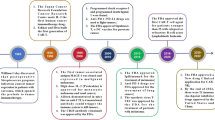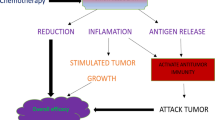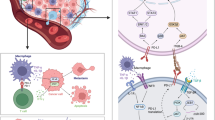Abstract
Purpose
IFN–inducible protein 10 (IP-10)/CXCL10 (CXC chemokine ligand 10) has been described as an antiangiogenic chemokine and displays a potent antitumor activity in vivo. In the present study, we try to investigate whether the combination therapy of hyperthermia, a physical antiangiogenic modality, with CXCL10 would completely eradicate the established solid tumors.
Methods
Immunocompetent BALB/c mice bearing Meth A fibrosarcoma were established. Mice were treated with either CXCL10 at 25 μg/kg once a day for 20 days, hyperthermia was given twice (at 42°C for 1 h, on day 6 and 12 after the initiation of CXCL10), or together. Tumor volume and survival time were observed. The microvessel density was determined by CD31 immunofluorescence. Histologic analysis and assessment of apoptotic cells were also conducted in tumor tissues.
Results
The results showed that CXCL10 and hyperthermia inhibited the growth of Meth A fibrosarcoma and interestingly, the combination therapy enhanced the antiangiogenic effects and completely eradicated the established solid tumors. Histological examination revealed that CXCL10 + hyperthermia led to increased induction of apoptosis, tumor necrosis, and elevated lymphocyte infiltration compared with the controls. Moreover, the tumor eradicated animals developed a protective T-cell-dependent antitumor memory response against Meth A tumor cells rechallenge.
Conclusions
Our finding is that the combination therapy can achieve a synergistic antitumor efficacy, supporting the idea that the combination of two antiangiogenic agents may lead to improved clinical outcome. These findings could open new perspectives in clinical antitumor therapy.





Similar content being viewed by others
References
Amir A, Kenneth EL, Axel S, Heike Z, Frank K, Daniel P, Alexandra R, Xiaohong H, Martin K, Marc B, Philip H, Hermann-Josef G et al (2003) Combined therapy with direct and indirect angiogenesis inhibition results in enhanced antiangiogenic and antitumor effects. Cancer Res 63:8890–8898
Andrew LF, Josef F, Titia EL, Steven KL, Dominique L, Marshall SM, Ewa MT, Stephen MH, Richard AH (2002) Retroviral gene transfer of interferon-γ-inducible protein 10 inhibits growth of human melanoma xenografts. Int J Cancer 99:149–153
Arenberg DA, Kunkel SL, Polverini PJ, Morris SB, Burdick MD, Glass MC, Taub DT, Iannettoni MD, Whyte RI, Strieter RM (1996) Interferon-γ-inducible protein (IP-10) is an angiostatic factor that inhibits human non-small cell lung cancer (NSCLC) tumorigenesis and spontaneous metastasis. J Exp Med 184:981–992
Arenberg DA, White ES, Burdick MD, Strom SR, Strieter RM (2001) Improved survival in tumor-bearing SCIDmice treated with interferon-γ-inducible protein 10(IP-10/ CXCL10). Cancer Immunol Immunother 50:533–538
Baggiolini M (1998) Chemokines and leukocyte traffic. Nature 392:565–568
Baggiolini M, Dewald B, Moser B (1997) Human chemokines: an update. Ann Rev Immunol 15:675–705
Barrett JR (1997) Chemokines. Blood 90:909–928
Ben-sasson SA, Sherman Y, Gavrieli Y (1995) Identification of dying cells—in situ staining. Methods Cell Biol 46:29–39
Bergers G, Javaherian K, Lo KM, Folkman J, Hanahan D (1999) Effects of angiogenesis inhibitors on multistage carcinogenesis in mice. Science 284:808–812
Bernhard VS, Olivier M, Wei-Jian Z, John M, Savio LCW (2000) Adenovirus-mediated gene transfer of endostatin in vivo results in high level of transgene expression and inhibition of tumor growth and metastases. PNAS 97:4802–4807
Calderwood SK, Theriault JR, Gong J (2005) Message in a bottle: role of the 70-kDa heat shock protein family in anti-tumor immunity. Eur J Immunol 35:2518–2527
Cristina R, Luca P, Donatella V, Anna C, Paul D, Peter C, Pietro G, Federico B (2003) Hyperthermia inhibits angiogenesis by a plasminogen activator inhibitor. Cancer Res 63:1500–1507
Dewey WC (1994) Arrhenius relationships from the molecule and cell to the clinic. Int J Hyperthermia 10:457–483
Falk MH, Issels RD (2001) Hyperthermia in oncology. Int J Hyperthermia 17:1–18
Folkman J (1995) Angiogenesis in cancer, vascular, rheumatoid and other disease. Nat Med 1:27–31
Frank P, Arndt van O, William HM (2005) Hyperthermia-induced proteasome inhibition and loss of androgen receptor expression in human prostate cancer cells. Cancer Res 65:4836–4843
Gang L, Ling T, Jian-mei H, Zhen-yu D, Qiu-ming H, Ping F, Yan-junW, Fei X, BingY, Ru Z, Feng P, Yu J et al (2005) Improved therapeutic effectiveness by combining recombinant CXC chemokine ligand10 with cisplatin in solid tumors. Clin Cancer Res 11:4217–4224
Hanahan D, Folkman J (1996) Patterns and emerging mechanisms of the angiogenic switch during tumorigenesis. Cell 86:353–364
Helena JM, Nader NH, Michael AB, David HG, Mary-Jane S, Kerri AS, Kevin B, Ruth H, Stephen G, Mohanraj D, Gerald AS, Vikas PS et al (1998) Weichselbaum. Combined effects of angiostatin and ionizing radiation in antitumour therapy. Nature 394:287–291
Ji-yan L, Yu-quan W, Li Y, Xia Z, Ling T, Jian-mei H, Ting N, Fen L, Yu J, Bing H, Yang W, Jing-mei S et al (2003) Immunotherapy of tumors with vaccine based on quail homologous vascular endothelial growth factor receptor-2. Blood 102:1815–1823
Kampinga HH, Dikomey E (2001) Hyperthermic radiosensitization: mode of action and clinical relevance. Int J Radiat Biol 77:399–408
Kaplan EL, Meier P (1958) Nonparametric estimation from incomplete observations. J Am Stat Assoc 53:475–481
Leonidas GK, Teresa Z-K, Edward CH, Kenneth C, James VS, Joshua MF (2001) Cytokine-responsive gene-2/IFN-inducible protein-10 expression in multiple models of liver and bile duct injury suggests a role in tissue regeneration. J Immunol 167(1):399–406
Li C-Y, Dewhirst MW (2002) Hyperthermia-regulated immunogene therapy. Int J Hyperthermia 18:586–596
Loetscher M, Gerber B, Loetscher P, Jones SA, Piali L, Clark-Lewis I, Baggiolini M, Moser B (1996) Chemokine receptor specific for IP10 and Mig: structure, function, and expression in activated T-lymphocytes. J Exp Med 184:963–969
Luster A (1998) Chemokines: chemotactic cytokines that mediate inflammation. N Engl J Med 228:436–445
Manjili MH, Wang X-Y, Park J, Macdonald IJ, Li Y, van Schie RCAA, Subjeck JR (2002) Cancer immunotherapy: stress proteins and hyperthermia. Int J Hyperthermia 18:506–520
Mototsugu K, Shin’ichi Y, Tatsumasa M, Yasumasa N, Shuuichi K, Naotoshi H, Keiko S, Keisuke S, Masahiro H (2001) The effects of KNK437, a novel inhibitor of heat shock protein synthesis, on the acquisition of thermotolerance in a murine transplantable tumor in vivo. Clin Cancer Res 7:215–219
Multhoff IG (2002) Activation of natural killer cells by heat shock protein 70. Int J Hyperthermia 18:576–585
Murphy PM, Baggiolini M, Charo IF, Hebert CA, Horuk R, Matsushima K, Miller LH, Oppenheim JJ, Power CA (2000) International union of pharmacology. XXII. Nomenclature for chemokine receptors. Pharmacol Rev 52(1):145–176
Overgaard J, Gonzalez Gonzalez D, Hulshof MC, Arcangeli G, Dahl O, Mella O, Bentzen SM (1995) Randomised trial of hyperthermia as adjuvant to radiotherapy for recurrent or metastatic malignant melanoma. Lancet 345:540–543
Peto R, Peto J (1972) A symptotically efficient rank invariant procedures. J R Stat Soc 135:185–207
Rau B, Wust P, Hohenberger P, Loffel J, Hunerbein M, Below C, Gellermann J, Speidel A, Vogl T, Riess H, Felix R, Schlag PM (1998) Preoperative hyperthermia combined with radiochemotherapy in locally advanced rectal cancer: a phase II clinical trial. Ann Surg 227:380–389
Robert MS, Peter JP, Steven LK, Douglas AA, Marie DB, James K, Judith D, Jo Van D, Alfred W, David M, Sham-Yuen C, Steven R et al (1995) The functional role of the ELR motif in CXC chemokine-mediated angiogenesis. J Biol Chem 270:27348–27357
Song CW (1984) Effect of local hyperthermia on blood flow and microenvironment: a review. Cancer Res 44:4721–4730
Srivastava P (2002) Roles of heat-shock proteins in innate and adaptive immunity. Nat Rev Immunol 2:185–194
Teicher BA, Sotomayor EA, Huang ZD (1992) Antiangiogenic agents potentiate cytotoxic cancer therapies against primary and metastatic disease. Cancer Res 52:6702–6704
Vabulas RM, Ahmad-Nejad P, Ghose S, Kirschning CJ, Issels RD, Wagner H (2002) HSP70 as endogenous stimulus of the Toll/interleukin-1 receptor signal pathway. J Biol Chem 277:15107–15112
Wessalowski R, Kruck H, Pape H, Kahn T, Willers R, Gobel R (1998) Hyperthermia for the treatment of patients with malignant germ cell tumors. Cancer 82:793–800
Xiao-ling X, Ru-han J, Ding-ping Y, Guo-hua D (2006) Irbesartan attenuates contrast media-induced NRK-52E cells apoptosis. Pharmacol Res 54:253–260
Yang JC, Haworth L, Sherry RM, Hwu P, Schwartzentruber DJ, Topalian SL, Steinberg SM, Chen HX, Rosenberg SA (2003) A randomized trial of bevacizumab, an anti-vascular endothelial growth factor antibody, for metastatic renal cancer. N Engl J Med 349:427–434
Yao L, Pike SE, Pittaluga S, Cherney P, Gupta G, Jaffe ES, Tosato G (2002) Anti-tumor activities of the angiogenesis inhibitors interferon-inducible protein-10 and the calreticulin fragment vasostatin. Cancer Immunol Immunother 51:358–366
Yokoyama Y, Dhanabal M, Griffioen AW, Sukhatme VP, Ramakrishnan S (2000) Synergy between angiostatin and endostatin: inhibition of ovarian cancer growth. Cancer Res 60:2190–2196
Yu-Quan W, Qing-Ru W, Xia Z, Li Y, Ling T, You L, Bin K, Chong-Jiu L, Mei-Juan H, Yan-Yan L, Fei X, Qiu-Ming H et al (2000) Immunotherapy of tumors with xenogeneic endothelial cells as a vaccine. Nat Med 6:1160–1166
Acknowledgments
This work was supported by National Basic Research Program of China (2001CB510001, 2004CB518800), the projects of National Natural Science Foundation of China, and National 863 Program.
Author information
Authors and Affiliations
Corresponding authors
Additional information
Ping Chen, Ling-lin Yang, Huo-zhen Hu, and Yu-quan Wei contributed equally to this work.
Rights and permissions
About this article
Cite this article
Chen, P., Yang, Ll., Yang, Hs. et al. Synergistic antitumor effect of CXCL10 with hyperthermia. J Cancer Res Clin Oncol 134, 679–687 (2008). https://doi.org/10.1007/s00432-007-0337-3
Received:
Accepted:
Published:
Issue Date:
DOI: https://doi.org/10.1007/s00432-007-0337-3




